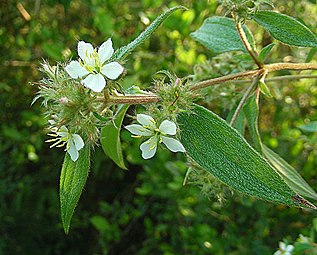Chaetogastra longifolia
| Chaetogastra longifolia | |
|---|---|

| |
| Scientific classification | |
| Kingdom: | Plantae |
| Clade: | Tracheophytes |
| Clade: | Angiosperms |
| Clade: | Eudicots |
| Clade: | Rosids |
| Order: | Myrtales |
| Family: | Melastomataceae |
| Genus: | Chaetogastra |
| Species: | C. longifolia
|
| Binomial name | |
| Chaetogastra longifolia (Vahl) DC.[1]
| |
| Synonyms[1] | |
| |
Chaetogastra longifolia is a species of flowering plant in the family Melastomataceae, native to Mexico through the Caribbean to northern South America. It has many synonyms, including Tibouchina longifolia.[1] It was first described in 1797 by Martin Vahl as Rhexia longifolia.[2][3]
-
Closeup of flowers and leaves
References[edit]
- ^ a b c "Chaetogastra longifolia (Vahl) DC.", Plants of the World Online, Royal Botanic Gardens, Kew, retrieved 2022-05-08
- ^ "Chaetogastra longifolia (Vahl) DC.", Tropicos, Missouri Botanical Garden, retrieved 2022-05-08
- ^ "Rhexia longifolia Vahl", The International Plant Names Index, retrieved 2022-05-08

